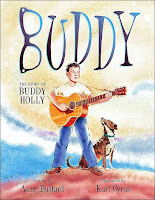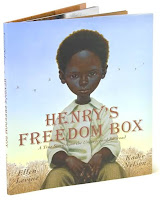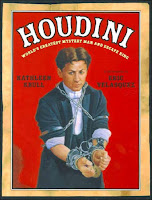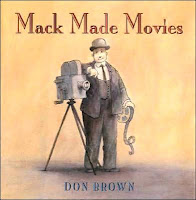Nonfiction picture books are written with great intention. By that, I mean that everything from the illustration to word choice paints a picture that truthfully depicts something about the subject.
A life fully lived is fraught with a roller coaster of human experiences. It makes sense that the particular focus or angle a writer chooses, and the age of the intended reader, somewhat dictates the tone he/she will aim for when penning the story.
If we can liken Focus and Angle to the zooming in of a lens, surely language, like background music, sets an intentional tone.
Let’s examine a few titles that demonstrate the language-tone paradox.
Mack Made Movies, written and illustrated by Don Brown (Roaring Brook, 2003) 1205 words.
One of my all-time favorite first-lines immediately sets the tone for this charming biography. “In 1900, twenty-year old Mack Sennett was a horse’s rear end.” The first illustration humorously reveals Sennett on stage, literally playing a horse’s rear end. Immediately, the reader assumes the story will reveal a fun and silly side to this man. Certainly, Brown doesn’t ignore Sennett’s inevitable disappointments as he pursued a show-biz career, but the language is infused with a lighthearted tone. “He learned slapstick, a kick-in-the-pants, slip-on-a-banana-peel kind of physical humor.”
Mack Sennett went on to become a director of silent movies, creator of Keystone Kops, and is credited with first hiring Charlie Chaplin.
“In the end, the horse’s rear end had gotten all the applause.”
Would Mack Sennett be memorable to kids without this comedic approach?
Buddy: The Story of Buddy Holly, by Anne Bustard, illustrated by Kurt Cyrus (Simon & Schuster, 2005) 948 words.
Another great example of language that sets a tone. “A time or two ago, out West Texas way, where tumbleweeds rolled down flat, dusty streets and the sunny sun and the starry stars shined brighter than bright, a good-hearted family howdied their newest young’un into this ol’ world.” The southern drawl in the text vividly paints Buddy Holly as a southern boy, but there is a musical quality to the words that fit his character to a tee. “Buddy stuck to that guitar like white on rice. He played and played and played some more.” “Whoo-de-doo. That guitar set Buddy’s spirits a-soarin’. Soarin’ on the windy wind.”
Henry’s Freedom Box by Ellen Levine, illustrated by Kadir Nelson (Scholastic Press, 2007) 1260 words
A radical departure from previous examples, the opening page sets a different tone, with the image of an unsmiling child. “Henry Brown wasn’t sure how old he was. Henry was a slave. And slaves weren’t allowed to know their birthdays.”
Right away, the reader knows this isn’t a lighthearted story. This is a heavier view of the human experience as shown through Henry’s eyes. The language is simple, and intentionally stark, as when Henry watches his family being sold, leaving him alone, “Henry watched his children disappear down the road. Where was Nancy? He saw her the same moment she saw him. When he wiped away his tears, Nancy, too, was gone.”
As all books for young readers should, the story ends with hope. Hope for Henry and hope for the goodness in mankind, as when two white men, opposed to slavery, helped Henry with the wild idea to mail himself in a box to a slave-free friend. “He awoke to loud knocking. ‘Henry, are you all right in there?” “All right!” he answered. “Four men smiled at him. “Welcome to Philadelphia!”
“At last Henry had a birthday- March 30, 1849, his first day of freedom!”
Fartiste, by Kathleen Krull, illustrated by Boris Kulikov (Simon & Schuster, 2008)
Perhaps the most daring and creative example of tone and language, this picture book biography is sure to make adults blush and children cackle out loud. And, to set it apart even more, it is in rhyme! From this simple stanza, introducing the subject as a child, can you identify how Krull chose to focus on this artist’s…ahem…talents?
“High or low, soft or loud, and sweet, even tart—
He was honing his skill: the art of the fart.
Noise from his backside—wow, what a gift!
His fartistic training was amazingly swift.”
Of course, Joseph Pujol grows throughout the story, perfecting his unique art and performing around the world. The language stays true throughout.
“One day a baker with butter and yeast,
And the next-voila!-he was Joe, the Fartiste.”
Krull has utilized a clever, kid-friendly way of introducing this oh-so-unconventional artist.
“Nurses were stationed in the aisles to scout
For those laughing so hard they completely passed out.”
Houdini: World’s Greatest Mystery Man and Escape King, by Kathleen Krull, illustrated by Eric Velasquez (Walker & Co, 2005) 2179 words
Houdini was a man of mystery and breathtaking risks. Krull intentionally chose to paint the word pictures with just such a tone. Listen to the drama in the very first scene.
“His assistants pour twenty pails of water into the can. They handcuff him, then help him inside. He shrinks, he curls, he takes a big gulp of air. The assistants fill the can to the top, then latch it. Click, click, click- six padlocks in all.” Pure, in-the-moment drama. There is another unique aspect to this particular book. The structure alternates between biographical progression and thematic scenes from Houdini’s performances, which add immediacy and climactic interest.
As you see by these select few examples, carefully crafted language can create rhythm, emotion, drama, and kid appeal to any nonfiction topic.







Thank you for this post! My middle child has to read books from all genres for her assigned summer school homework and you have reminded me of some great books for her to read for non-fiction.
Pragmatic Mom
Type A Parenting for the Modern World
http://PragmaticMom.com
I blog on parenting, chidlren's lit and education
ps I also have Henry's Freedom Box on my Top 10: African American Picture Books list at http://www.pragmaticmom.com/?p=6058
I use 10 great picture books to tell the story of the African American Experience from slavery, civil war, Civil Rights Movement, to now.
Thanks again for chiming in. It's nice to know someone is reading my blog.
Henry's Freedom Box is one of my all-time favorites, too. And Kadir Nelson's amazing illustrations add so very much to the story. I'll explore illustrations in a future post.
By the way, I popped over to your website. Very cool! Congratulations!